
 |
How to protect glazed pictures from climatic insult |
Henriette Berg, Nina Dahlstrøm, Tim Padfield and Anna-Grethe Rischel
Conservation Department, The National Museum of Denmark
Paper prints framed behind glass are at risk from moisture movement caused by temperature gradients, both transient and seasonal. The temperature gradient can be reduced by mounting pictures about 2 cm from the wall and by preventing direct sunlight illuminating the picture. Insulation behind the picture is less useful and is dangerous if sunlight shines on the picture.
If the picture is already at equilibrium with a high RH, even a small temperature gradient will cause condensation on the glass or in the backing material. Water can even be absorbed into the picture from condensation on the wall behind it. Sealing the back of the frame greatly improves the moisture stability of the enclosure. An absorbent back board within the sealed space stabilises the picture against changes of ambient RH but destabilises the RH at the picture when transient temperature gradients arise.
A downloadable, more formal version of this paper is available in pdf (800Kb)
Art on paper which is displayed framed behind glass is commonly exposed to the untamed outdoor climate, as posters, public notices and restaurant menus. One might think that framed pictures in museums would not be exposed to a threatening climate but there are pictures hanging in open air museums on the flimsy walls of the houses of the poor peasants of olden times and there are ornately framed pictures hanging in the draughty discomfort of the palace museums of the once rich and influential. Even in a modern air conditioned museum, a shaft of sunlight playing briefly on the picture will heat it over fifty degrees, depending on its colour.
We describe the microclimate within a picture frame and suggest how best to enclose pictures which will be displayed in an imperfectly controlled climate.
The microclimate within small enclosures filled with water absorbent materials is controlled by the continuous exchange of water between the materials and the immediately surrounding air. The ratio of the weight of absorbent material to the weight of air within the enclosure is so high that it is the water content of the material that controls the water vapour concentration of the air, in contrast to the world outside the enclosure, where the moisture content of the air controls the water content of absorbent materials.
If a temperature gradient develops through the layer structure of a framed picture there will be moisture migration within the enclosure. The governing principle is that the enclosure tends towards a uniform moisture content in the air spaces, through diffusive movement of water vapour. This means that the relative humidity (RH) will be higher in the cooler part of the structure, because the RH is the ratio of the water vapour concentration within a space to the maximum possible concentration at that temperature. This maximum concentration diminishes with temperature, so if the actual concentration is uniform the RH must be higher in the cooler parts.
The non-uniform RH generated by the temperature gradient will cause the absorbent materials in the enclosure to attain different water contents. A water content gradient will develop, with the highest water content in the coolest material. A considerable gradient can arise even within the thickness of the backboard. Water will move within the material to even out the water content. However, the RH in the pore spaces is in equilibrium with the water content of the immediately adjacent material, so the movement of water molecules through the material will cause water vapour concentration changes in the air that oppose the tendency towards a uniform water vapour concentration in the pore spaces. In fibrous materials this movement of water through the material can be expected to be slow compared with the diffusive movement of water vapour the other way.
The standard methods for measuring water movement through porous materials do not distinguish between movement of water molecules through the pore space and movement through the solid material that surrounds the pores, so the relative rates of these processes have not been determined for any material.
Even though the water vapour concentration tends towards uniformity it will not remain constant as a temperature gradient develops. There are two reasons for this. The RH in the pore spaces remains nearly constant as absorbent materials cool. Furthermore, absorbent materials do not absorb water in proportion to an increasing RH around them.
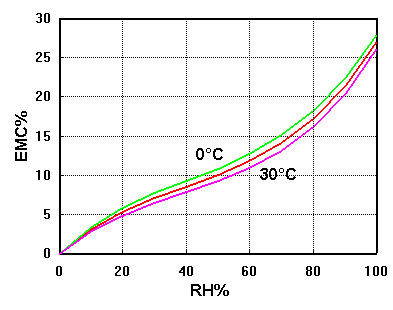
Figure 1. The water absorption of cotton. Notice the increasing absorption at high RH and the rather small influence of temperature on the absorption. The consequences of the temperature insensitivity of the sorption curve is explored in detail in figure 11. Based on data from Urquhart and Williams (1).
Absorption is much higher at high RH. If the temperature gradient is so large that the RH tends to saturation at the cold side, the material will absorb so strongly that the water vapour concentration will be reduced throughout the enclosure.
If the RH reaches 100% at the cold side, water will be removed by condensation and the water vapour concentration in the air space will be controlled by the temperature of this cold surface. An extreme temperature gradient will therefore cause dehydration of the artwork, while dew appears on the glass, or on the back plate.
If an impermeable backing, such as aluminium foil is in close contact with the back board, so that the back surface of the back board is as cold as the aluminium, the condensed water will move by capillarity through the back board towards the warm side. At some point on this journey it will re-evaporate and the cycle will repeat.
If, however, the aluminium does not touch the back board at every point, dew will form as drops in the air spaces and there is then a possibility that dangerous wet spots will develop where the dew forms capillary streams into the back board at a few points of contact, or at the bottom of the frame. These streams of water may overwhelm the local absorptive capacity so that the water penetrates to the print and stains and cockles it, particularly as neighbouring parts of the print will be suffering dehydration.
A cold back to a picture is not usually a serious risk, because the condensed water is held in the capillary spaces between the fibres. However, if the glass front of the picture becomes the coldest part, the threat is more serious, because there is no water absorbent layer between the print and the glass. Dew will readily form on the glass, dribble down and stain the framing card, or the print itself. This phenomenon is widespread on restaurant menu displays, where the cold night air cools the glass but the back is kept warm and moist by heat and water vapour leaking from the warm building, typically an old uninsulated building.

Figure 2. Water is condensing on the glass which is cooled by the night air, obscuring the prices of the items on this menu in Copenhagen. The source of the water is the paper menu and its back board, which are warmed by the restaurant wall behind.
Sunlight playing on a picture behind glass will produce a complicated temperature gradient. The dark parts of the picture will be the hottest places. The temperature will diminish towards the glass in front and also towards the back. The temperature will also generally diminish towards the sides, because prints are usually surrounded by relatively pale mats. As a rule, the picture will dry and the edges of the mounting card will become the wettest part of the assembly. The glass will be warmed by re-radiation from the print at long wavelengths which are absorbed by the glass (the greenhouse effect). Condensation on the glass is therefore rare under these circumstances.
A dark mat, with a relatively pale picture can, however, cause condensation on the glass in front of the picture, which will be quite cool (figure 3).
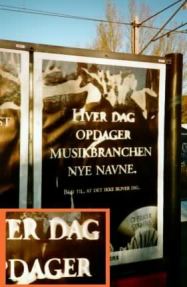
Figure 3. Condensation on the glass in front of a dark print warmed by the sun. The glass in front of the dark areas is warmed by re-radiation from the dark pigment. The glass in front of the white text is cooler, so it is there the water evaporated from the paper condenses.
The heating effect of sunlight through a glass window is the most extreme climatic insult that a museum print usually encounters. Figure 4 shows the construction of the framed pictures that we have used for experiments.
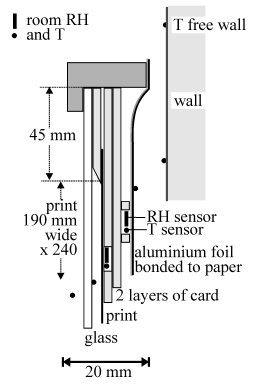
Figure 4. Cross section through the glazed frame of a print which has been fitted with moisture and temperature sensors to investigate the climatic influences discussed in this article.
The temperature of a dark surface illuminated by direct sunlight indoors, behind glass, will usually be at least fifty degrees. Radiation heating gives by far the most extreme temperature gradients that a picture must endure. A temperature gradient will also be caused by radiant cooling, where the dark picture loses heat to the cold night sky. This is a much smaller effect, because both the picture glass and the window glass absorb and re-radiate inwards some of the long wavelength radiation from the picture.
An insulated back to the frame will increase the risk of condensation on the glass. Pictures that will suffer short periods of direct sunlight, in historic houses for example, should be mounted so that heat can readily be lost from the back, ensuring that the glass is not the coldest part of the assembly. An air space and a black painted back board will usually suffice.
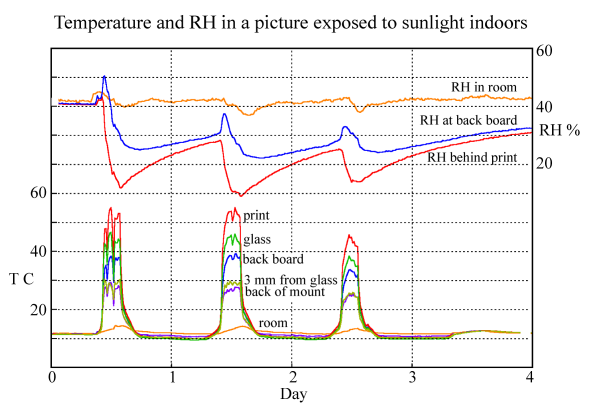
Figure 5. Temperature and relative humidity through a framed print exposed to sunlight through a double glazed window. The RH directly behind the print falls abruptly during the period of exposure. The RH at the back of the mount rises at first, fed by moisture released by the print. After that the RH falls at both measuring points. This is because the print is dark. The coolest part of the enclosure is the white mat and the outer edge of the back board. The moisture accumulates there and returns only slowly when the picture passes into the shade.
The discussion so far has centered on a sealed frame with a constant water content within. This is not the usual way of enclosing art behind glass. We have used this example to simplify already complex arguments describing the development of the microclimate.
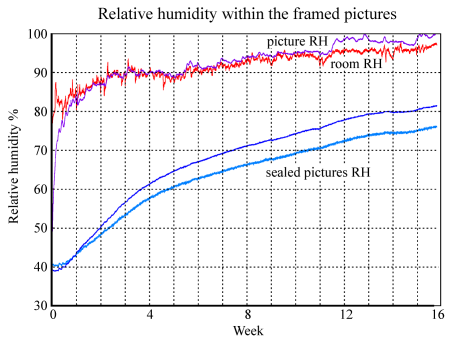
Figure 6. The course of the relative humidity immediately behind the print in three glazed frames exposed in an unheated house. The indoor RH averages about 90% during this winter period. One picture has no impermeable backing. It rapidly comes to equilibrium with the room air from its starting point at 40% RH. Towards the end of the period the RH at this picture rises above the room RH and close to 100%. The cause of this is discussed in the next graph. The other two pictures were covered on the back with aluminium coated paper, but were not otherwise sealed with particular care. At the end of the exposure period they were still far from equilibrium with the room air and were also more stable than the unsealed picture.
A picture with a porous back will quickly attain equilibrium with the room RH. Figure 6 shows the inferior moisture stability of an unsealed painting in an unheated house. A detail from this diagram, expanded in figure 7, shows a particular danger for unsealed paintings in a high ambient RH. A sudden drop in outside temperature briefly sent the inside wall surface below the dew point of the room air, whose temperature and RH were buffered by the structure and furnishings. The wall just behind the painting was the coolest part of the room, because it is slightly insulated against the inside temperature by the picture itself. This is therefore the place where condensation occurred. This condensation was absorbed into the back board by the very rapid capillary absorption of liquid water. The subsequent drying by diffusion was much slower. This episode occured at a low temperature, so the picture was also at risk from growth of ice crystals in the very humid paper.
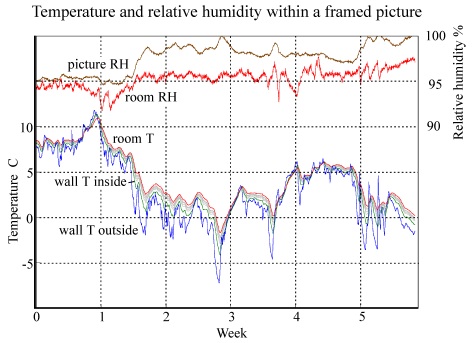
Figure 7. Condensation into the back of an unprotected picture. This is a detailed record from the last 6 weeks shown in figure 6. A sudden drop in outside temperature in the middle of the second week has caused the inside surface of the wall, where it is partly screened by the picture, to fall below the dew point of the room air, which is buffered in temperature and in RH by the building and its furnishings. The condensed moisture has been absorbed into the porous back board of the picture and caused a sudden and long lasting increase in the RH measured just behind the print.
In a heated room with a stable, moderate RH, there is no disadvantage to a porous back, but if the temperature is stable and the RH variable, as is usually the case in an ordinary house and in many museums, a sealed back ensures a much more stable moisture content in the picture.
The only argument against the sealed back is the danger of condensation when the picture is warmer than the back board. This usually occurs when direct sunlight plays on the picture, as already discussed, or when the picture is set close against a thin, uninsulated outer wall, as shown in figures 8 and 9.
The temperature gradient caused by a cold or warm outer wall can be made innocuously small by separating the picture from the wall by about 20 mm for a small picture, probably more for a large picture.
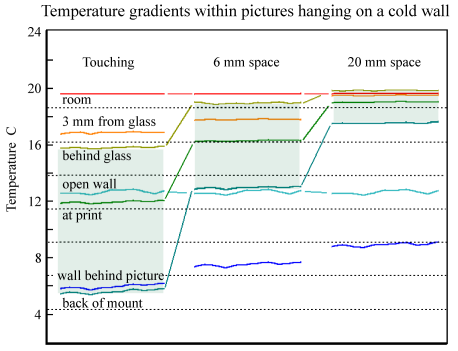
Figure 8. The temperature gradient through three pictures set against a cold outer wall. The shaded areas are the enclosed air space within the frame. Notice that the internal temperature gradient becomes very small when a 20 mm air gap is established between the back board and the wall. The wall behind the picture is noticeably cooler behind all the pictures. The room dew point was about 8°C, so there was condensation on the wall behind the two closest pictures. The sealed back of the picture hard up against the wall was below the dew point of the air within the enclosure, so there was condensation on the inside of the back plate. The climate within this picture is shown in detail in figure 9.

Figure 9. A detailed record of the microclimate in the picture close up against the wall. Before the picture was placed against the wall the RH at the print was sliding down towards 80%, tending towards equilibrium with the 45% RH in the room. As soon as the back of the picture was set against the cold wall the RH dropped. The first very rapid drop, at about day 2.6, is caused by the temperature change at the print. For a given water content, paper is in equilibrium with a lower RH at a lower temperature. The continuing fall in RH is caused by moisture transfer to the cooler back board. At the end of the period, day 8.5, the picture was removed from the wall, causing an instant increase in RH, due to the temperature rise at the back and transient absorption into the still cool print. The sealed back plate was immediately opened, revealing abundant condensation on the inner surface. The subsequent fall in RH was due to rapid equilibration of the opened frame with the room RH.
The temperature gradient can swing from one direction to the other during the daily cycle. The next diagram, figure 10, shows the microclimate in a picture set close against a thin, uninsulated south facing wall. A cold night was followed by hazy sunlight on the first day and strong sunlight on the second day. The exchange of moisture between the print and the back board is clearly shown. During the sunny period on the second day the heating was so strong that condensation appeared on the inside of the glass. Consequently, the RH fell both at the print and at the back board. The climate change during this episode is stretched out for clarity.
The RH at the print rises at first as the sun warms the wall (point A). Then there is a rapid decrease in RH at the hot back board to a low point at C. Water condenses on the glass, catching and staining the print where it bulges close to the glass. When the picture was quickly removed from the wall the RH at the print rose rapidly as water evaporated from the glass (B-E). The temperature behind the picture rose to 80°C, while the open wall temperature was just 58° (D).

Figure 10. The microclimate in a picture frame mounted against a thin wall that cools at night and gets warm in the sun. On day 1 there was only weak sunshine so the print warmed only a couple of degrees above the room temperature. There was nevertheless a considerable movement of water vapour from the back board to the print. When the wall cooled down again the backboard again acquired the higher RH. On day 2 the sun shone brightly. The wall became so hot that water from the back board condensed on the inside of the glass and was sucked into the paper where it bulged towards the glass. The details are shown in the time stretched enlargement on the right: The RH at the back fell steeply from A to C. The RH at the picture rose at first but then fell as water condensed on the glass. When the picture was removed from the wall at point B the RH at the print rose quickly at first, due to evaporation of the dew on the glass, later the RH fell again as the back board absorbed water.
There seems to be no advantage in thermally insulating the back of the mount. An air gap between mount and wall is normally adequate to reduce the temperature gradient to an unimportant magnitude. A picture mounted next to that shown in figure 10 but 20 mm from the wall, showed much less turmoil in its microclimate.
On the other hand, insulation behind the picture is dangerous when sun shines on the picture, because the back board will heat up. Condensation will then occur on the glass, which will be the coolest part of the assembly.
The main water reservoir in the framed picture is the back board and mat. Is there any advantage in replacing these by non-absorbent synthetic materials?
If the print is the only water absorbent material in the enclosure, there will be much less condensation when the temperature at the back, or at the glass, drops below the dewpoint of the air within the enclosure. Water inert backing will be an advantage for a restaurant menu in a shady street (in the climatic sense). In this case condensation will always occur on the glass, so the less water the better.
Menus exposed to the sun present a subtler problem. An absorbent material will buffer the increasing RH towards the cool back of the assembly, but if the gradient becomes extreme, the large amount of condensate may move by capillary processes to the print. A non-absorbent backing will provide much less resistance to this capillary flow. In this case only experiment can lead to enlightenment.
Such experiments could also include water resistant but vapour permeable membranes, such as microporous PTFE, thin silicone membranes and also laminated composites such as are used as unsymmetrical water-vapour barriers in roof construction. There is rich scope for experimentation in novel ways of preventing condensation damage, but in museums it is usually easier to draw the curtains in sunny weather. This elementary precaution has the advantage that it also reduces photochemical damage.
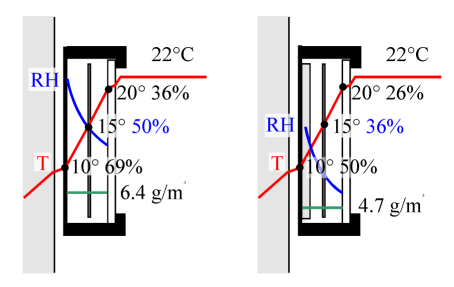
Figure 11. How a buffer at a different temperature de-stabilises the RH around the print. On the left, the print is the only absorbent material in a small, sealed container. Whatever its temperature, it will control the RH at its surface close to the 50% that it was in equilibrium with before the gradient was applied. On the right, a relatively massive buffer of card is at the cold side of the frame. It will buffer the RH at its surface a little lower than the 50% that it was originally in equilibrium with, according to figure 1. The uniform water vapour content in the enclosure is set by the card and is lower than in the setup on the left, because of the lower temperature of the card. The print will therefore be in a RH of 36% and will lose water. This water will increase the water content of the card, but, because of its greater mass, the proportional increase will be small and so the equilibrium RH at its surface will hardly rise above 50%.
The temperature gradient caused by other processes will very seldom result in dew formation, however much absorbent material there is in the enclosure. The change in water content of the print will, however, be greater when the backing material is absorbent, because a lot of water will move into the backing material even at temperatures above the dew point. This is the unbuffering process that sets in when a temperature gradient is established between the artwork, whose moisture stability is the prime concern, and the buffer material put in to stabilise the RH (figure 10). However, an absorbent mat is such an advantage in maintaining a constant water content in periods of uniform temperature that it is more sensible to ensure a uniform temperature rather than developing exotic enclosures.
The traditional way of mounting paper prints and watercolours can be improved by making the enclosure air tight. This is only really necessary in damp or unstable climates. The only disadvantage of an impermeable back is the risk of condensation under an extreme temperature gradient. Temperature gradients can be avoided by hanging pictures a few centimetres away from the wall and by ensuring that direct sunlight never shines upon them. Insulation behind the picture is not necessary and is a danger if direct sunlight falls on the picture, because then the glass is the coolest part and water will condense there.
The earliest reference we can find to separating pictures from the wall, and using impermeable back plates, is in: Josef Maria Eder. 'Rezepte tabellen und arbeitsvorschriften für photographie und reproductionstechnik' Wilhelm Knapp (publisher), Halle 1942 p 287 item 153: "Half centimetre thick cork pieces were placed at each corner of the frame so it did not lie directly against the damp wall. It is advantageous to place a foil of tin or zinc, or a thin glass plate between the picture and the wall behind."
1. Urquhart, A.R. and Williams, A.M. 'Absorption isotherm of cotton' , J.Textile Inst. 1924 pp 559-572.
2. The microclimate data were collected by a Campbell Scientific CR10X data logger with a multiplexer. The temperature sensors were type K thermocouples made from 0.1 mm wire. Type K has a lower thermal conductivity than the customary type T thermocouple. This is an advantage for measuring temperatures on surfaces and in laminates in a steep temperature gradient. The RH was measured with Honeywell HIH3605B capacitive sensors. These are very small: 4 x 9 x 1.2 mm. The electronics is integrated with the sensor. The output is linear 1 to 4 volts (0% - 100% RH) when excited by a 5V supply. The signal voltage was halved by an operational amplifier to match the input of the data logger.
Technical details of the experimental methods can be obtained from Tim Padfield, tim@padfield.dk
Conservation Department, The National Museum of Denmark, Brede DK-2800 Lyngby

This work is licensed under a Creative Commons Attribution-Noncommercial-No Derivative Works 3.0 License.